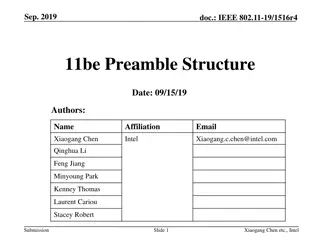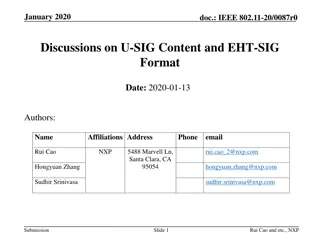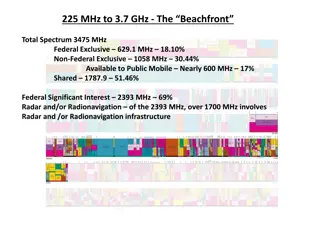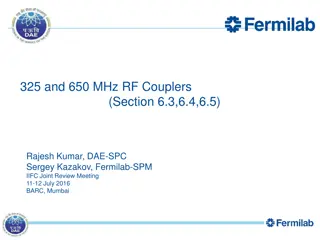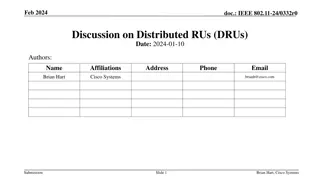Overview of ESRF-EBS 352 MHz RF System Upgrade at 26th ESL RF Meeting
The 26th ESL RF Meeting held at Elettra in Trieste discussed the status and upgrades of the ESRF-EBS 352 MHz RF system. The meeting covered topics such as the EBS RF layout, HOM damped cavities, RF ECO-Mode, ongoing RF projects, and the replacement of klystrons with SSAs for a 4th harmonic RF system
0 views • 16 slides
BOBCAT 320 322 EXCAVATOR Service Repair Manual Instant Download (320 SN 223911001 & Above, 322 SN 224011001 & Above)
Please open the website below to get the complete manual\n\n\/\/ \n
0 views • 52 slides
Introduction to IEEE 802.11-20 EHT PPE Thresholds Field
IEEE 802.11-20 standard defines the Nominal Packet Padding values and Pre-FEC Padding Factors for PE fields in 11ax. The selection of Nominal Packet Padding values is crucial and can be determined using specific methods, including PPE Thresholds Present subfield. The PPE Thresholds field contains in
0 views • 14 slides
Challenges and Requirements for Bandwidth Indication in IEEE 802.11
The document discusses challenges and requirements related to bandwidth indication in RTS/CTS frames with PPDU in 320 MHz, focusing on scenarios where bandwidth signaling may lead to misinterpretation by stations. It highlights the need for dynamic bandwidth and preamble puncturing information in RT
3 views • 21 slides
IEEE 802.11-20/0668r1: EHT BSS Configuration Proposal
The document discusses the configuration of a 320 MHz BSS in the context of 6 GHz regulations, focusing on EHT operation elements such as channel width indication, CCFS principles, and BSS advertisement settings. It proposes design principles for managing legacy and EHT STA operations, emphasizing s
0 views • 14 slides
Design Considerations for Partial Bandwidth Information in IEEE 802.11-20/1747r1
Design considerations for partial bandwidth information in the IEEE 802.11-20/1747r1 standard are discussed, focusing on EHT NDPA frame structure, feedback mechanisms, bitmap design, and table-based designs to support large RU/MRUs. The feedback mechanism utilizes bitmap resolution signals, providin
1 views • 10 slides
Bitmap Indication for OFDMA Transmission
Dec. 2020 introduces a preamble puncture bitmap indication for 20/40 MHz OFDMA transmission, proposing to use '1111' when no puncturing is applied. The straw poll suggests adding this indication to the TGbe SFD. The submission highlights the specific bit values for punctured 20 MHz channels within a
2 views • 5 slides
Bandwidth Indication for EHT BSS in IEEE 802.11-20/0680r0
This IEEE document discusses the proposal to use an Enhanced High Throughput (EHT) operation element to indicate operating bandwidth for EHT Basic Service Sets (BSS). It suggests methods for indicating channel configurations, punctured channels, and channel width for EHT stations. The goal is to ena
0 views • 15 slides
Designing 9-Bit RU Allocation Subfield for EHT Trigger Frame in IEEE 802.11-20
IEEE 802.11-20/1845r2 presents a proposal for enhancing the RU allocation subfield design in the EHT Trigger frame to accommodate bandwidth support up to 320MHz and multiple RU or MRU allocations for UL MU transmissions in the 11be standard. The modification addresses inconsistencies in MRU mapping
0 views • 34 slides
IEEE 802.11-20/0985r5 RU Allocation Subfield Design in EHT-SIG
The document discusses the design of subfields in EHT-SIG for RU allocation in IEEE 802.11be, focusing on reducing overhead by considering supported large-size MRU combinations. It addresses concerns on entries overhead in the RU allocation subfield table and the clarity of support for specific MRU
3 views • 24 slides
IEEE 802.11-20/1238r5 August 2020 Preamble Design Open Issues
In these slides, designs for U-SIG content & overflow and EHT-SIG design are proposed. The focus is on punctured channel indication design with the aim of conveying puncturing patterns efficiently while keeping signaling overhead low. The proposal includes a 6-bit field for puncturing information, a
1 views • 41 slides
IEEE 802.11-20/0029r3 Preamble Structure and SIG Contents Overview
The document dated January 2020 discusses the preamble structure and SIG contents, focusing on EHT-SIG in IEEE 802.11-20/0029r3 amendment. It covers the introduction of U-SIG, EHT-SIG format, EHT.PPDU types, and EHT-SIG design for MU PPDU. The discussion includes the necessity of accommodating overf
3 views • 22 slides
Final Exam Review for AAE 320 - Paul D. Mitchell
Get ready for the final exam in AAE 320 with an overview of new topics, an explanation of what to expect, and tips on how to study effectively. Covering subjects like ag policy, federal support of US agriculture, commodity programs, and more, this review will help you prepare for success. Don't miss
0 views • 17 slides
IEEE 802.11-20/0479r0 240 MHz Channelization Options
The document discusses agreements on 240 MHz channelization in IEEE 802.11-20/0479r0, presenting three options: contiguous non-overlapping channels, any combination of three consecutive 80 MHz channels, and puncturing of a 320 MHz channel. Various considerations and questions are raised regarding th
0 views • 12 slides
Discussion on Multi-RU Allocation in IEEE 802.11be Standard
In January 2020, a discussion took place on the allocation of multiple Resource Units (RUs) to a single Station (STA) in the IEEE 802.11be standard. The proposal suggested categorizing RUs into small and large types, avoiding aggregation across multiple 20MHz channels. It emphasized assigning a sing
2 views • 29 slides
Proposal for EHT 320 MHz PPDU Support in EDCA Ranging for IEEE 802.11-23/0391r1
The document outlines a proposal to enable EHT 320 MHz PPDU support for EDCA ranging in IEEE 802.11-23/0391r1. It discusses the implementation of FTM legacy ranging, the importance of wider bandwidths, and the necessary changes in the standard to incorporate this support. The proposal aims to enhanc
0 views • 6 slides
IEEE 802.11-20/0095 PHY-Related Agreements for SST
IEEE 802.11-20/0095 outlines agreements related to PHY aspects impacting the definition of Spatial Stream Tapping (SST) in 802.11 standards. The focus is on enabling 80 MHz operating stations to participate in 160 MHz OFDMA, including in non-primary 80 MHz scenarios. Various considerations and scena
1 views • 11 slides
Proposed 80 MHz EHT LPI PPDU Format for IEEE 802.11-20/1347r1
The document presents the proposed LPI PPDU format for IEEE 802.11-20/1347r1, focusing on enhancing the robustness of the preamble and payload in non-OFDMA frames. The format includes repetitions of U-SIG and E-SIG symbols, optimizing DCM gain for improved performance. Simulation results show advant
0 views • 12 slides
Stylish Apartment Available for Sale at $320,000 - Ver. A
Enjoy the opportunity to own a stylish apartment listed at $320,000, featuring modern design elements. This apartment was documented on 25th November 2018 under version A. With a contemporary aesthetic and a comfortable living space, this property could be your perfect new home. Explore the images t
0 views • 4 slides
IEEE 802.11-19/1516r4: 11be Preamble Structure Overview
The document discusses the design and structure of the 11be preamble in IEEE 802.11-19/1516r4. It emphasizes reusing existing functions from previous WiFi generations and focusing on features that enhance user experience. The preamble includes elements such as Pre-EHT preamble, EHT preamble, legacy
0 views • 13 slides
IEEE 802.11-21/0012r1 Considerations on Open Issues in PHY Requirements
In the January 2021 document IEEE 802.11-21/0012r1, discussions were held on open issues related to PHY requirements, including LO requirements for 320 MHz transmission, EVM requirements for 1024 QAM and BPSK-DCM-DUP, minimum sensitivity for 4K QAM and BPSK-DCM-DUP, and channel rejection levels. Sug
0 views • 12 slides
Channelization and Tone Plan Discussion for 320MHz EHT
IEEE 802.11-19/0797r1 discusses the channelization and tone plan design for 320MHz in EHT (11be). The slides cover the benefits of a 320MHz channel, double peak throughput, various BW modes, existing and new configurations, and proposals for tone plans to maximize efficiency. Detailed considerations
0 views • 10 slides
IEEE 802.11-20/0087r0 Discussions on U-SIG Content and EHT-SIG Format
In January 2020, NXP presented a document discussing the U-SIG content and EHT-SIG format within the IEEE 802.11-20/0087r0 framework. The document elaborates on the structure and encoding of U-SIG fields, version-dependent and version-independent bits, as well as the EHT-SIG structure for SU/MU tran
0 views • 10 slides
Efficient Preamble Puncturing Support for IEEE 802.11 EHT Wide Bandwidth Transmission
The IEEE 802.11-20/0895r0 document addresses the introduction, issues, motivation, and support for preamble puncturing in EHT transmissions. It focuses on optimizing resource allocation while facilitating flexible preamble puncturing for OFDMA transmission in wide bandwidth scenarios, such as managi
0 views • 14 slides
PAPR Issues in EHT-ER-SU PPDU for 6GHz Wi-Fi Systems
Introduction of a new PPDU type (EHT-ER-SU) for extending transmission range in 6GHz Wi-Fi systems has led to PAPR issues due to frequency-duplicated data, impacting indoor and outdoor usage. Proposed methods aim to reduce PAPR, addressing concerns for indoor STAs and outdoor support in high-power s
0 views • 10 slides
Way Forward on Release Independence for 35 and 45 MHz in Mobile Networks
Discussion at the 3GPP TSG-RAN-WG4 Meeting #97-e focused on release options for 35 and 45 MHz frequencies. Different options were explored for release independence, hardware capabilities, backward compatibility issues, and commercial implementation aspects concerning various stakeholders such as T-M
0 views • 10 slides
Military Spectrum Utilization in the 225-399.9 MHz Band
The 225-399.9 MHz band is crucial for military operations, utilized by NATO, allied nations, and the Coast Guard for tactical and strategic communications. It supports mobile-satellite systems, MUOS, air-to-ground communication, and more. The band also facilitates aeronautical communication, trunked
2 views • 21 slides
Progress and Scope of 325 and 650 MHz RF Couplers
The document outlines the technical progress and scope of work regarding the development of 325 MHz and 650 MHz RF couplers for the Joint Review Meeting. It includes details on milestones, design and fabrication timelines, prototype testing results, production updates, and plans for increasing power
0 views • 16 slides
Enhancing Spectrum Efficiency with Low Complexity Erasure Codes in IEEE 802.11 Document
This document delves into the implementation of erasure codes for content channels in IEEE 802.11 systems. By utilizing erasure codes, spectrum efficiency can be boosted without significantly increasing the complexity of encoding and decoding processes. The discussion also covers the duplication of
0 views • 20 slides
Development of 650 MHz RF Power Systems for PIP-II Linac
The project involves designing and fabricating 325 MHz and 650 MHz RF power systems for PIP-II Linac. Various milestones, including the development of 40 kW RF systems, testing prototypes, and collaboration between RRCAT and Fermilab, are outlined. The high-level goal is to achieve specific power le
0 views • 16 slides
AN/PRC-117F Characteristics Overview
AN/PRC-117F (or R/T-1796) is a versatile radio system with a frequency range from 30 MHz to 512 MHz, covering VHF-LOW, VHF-HIGH, UHF, SATCOM, SINCGARS, and HAVE QUICK modes. It offers multiple modulation methods, programmable presets, ECCM features, power outputs, and encryption capabilities. With a
0 views • 25 slides
IEEE 802.11-19/1606r0 Preamble Puncturing and SIG-B Signaling
EHT, an enhancement to the IEEE 802.11 standard, aims to improve channel access in dense environments using wider bandwidth operation. This document discusses the design considerations for SIG-B content channels and preamble puncturing in the context of EHT's support for 320MHz bandwidth and multipl
0 views • 14 slides
IEEE 802.11-23/1067r1 TB Ranging with EHT and HE TB PPDU Overview
This document discusses the use of 320 MHz bandwidth in TB ranging for IEEE 802.11-23/1067r1, focusing on EHT and HE TB frames. It examines the decision trees regarding the use of EHT TB ranging NDP, limitations on frame mixing, and bandwidth reduction for Location Measurement Report (LMR). Key cons
0 views • 8 slides
XL-320 Dynamixel Wizard Settings and Screenshots Overview
Explore the XL-320 Dynamixel Wizard settings and screenshots, learn how to enable torque, set goal velocity, switch between Joint and Wheel modes, adjust goal positions, and more. Updated on 12/14/19, experience a detailed guide to configuring your XL-320 Dynamixel motor for optimal performance.
0 views • 11 slides
Thermal and Mechanical Simulation of Beryllium Window for MICE 201 MHz Cavity
Conducted thermal and mechanical simulations using TEM3P for the beryllium window of the MICE 201 MHz cavity. Analysis focused on temperature distribution, frequency shifts, thermal deformation control, and stress considerations under varying operation conditions and material properties. Detailed in
0 views • 11 slides
IEEE 802.11-20/1317r1 EHT-SIG Proposal Discussion
The document discusses EHT-SIG for single-user and sounding NDP in IEEE 802.11-20/1317r1, focusing on overflow bits, user fields, CRC, and tail formats. It covers the format details, subfields, and overhead compared to HE sounding, proposing specific bit allocations for different elements. The EHT-S
0 views • 16 slides
Design Considerations for AR/VR on EHT in IEEE 802.11-19/1780r0
Explore the detailed design considerations and use cases for AR/VR applications on EHT in the IEEE 802.11-19/1780r0 document. The document covers various aspects such as KPIs, timing diagrams, simulation results, comparisons with 5GNR, source of latency in 802.11, and suggestions for optimizing perf
0 views • 15 slides
Relevance of Lean PHY for EHT in 6 GHz
Discussing the importance of a Lean PHY for EHT in 6 GHz to improve spectrum efficiency and reduce overhead. Introducing the Low Throughput PHY as a potential solution, highlighting its benefits compared to existing options like 802.11a. Measurement results show the impact and potential for enhancin
0 views • 14 slides
Decoupling Channel Training Length for EHT Evaluation in IEEE 802.11 - 20/0486r0
Evaluation of decoupling channel training length from the number of streams for EHT in IEEE 802.11. The impact of noise on channel estimation error in data symbol detection is assessed, highlighting techniques for noise improvement. Further insights into 11ax training sequences are provided, along w
0 views • 13 slides
Discussion on Distributed RUs (DRUs) in IEEE 802.11-24/0332r0
The document discusses Distributed RUs (DRUs) as a solution to work around 6 GHz regulations limiting transmit PSD per MHz. DRU energizes a few subcarriers per MHz to improve link budget by 11 dB at the cost of data rate scaling. It also examines the problem of throughput degradation in DRU with ins
0 views • 9 slides



















